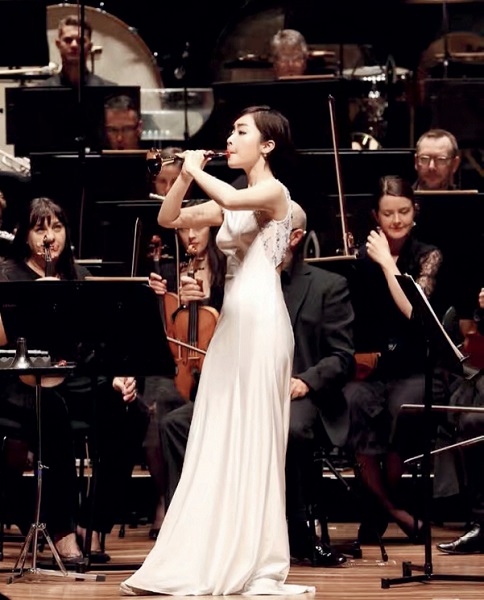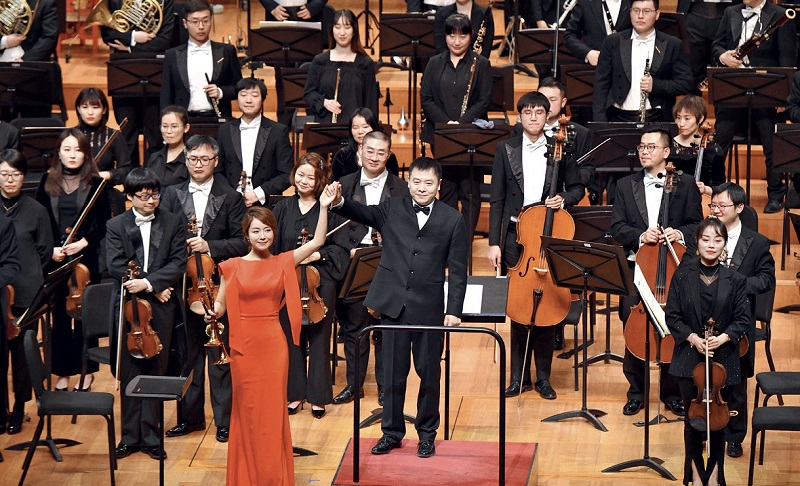China’s first artist to get a Ph.D. in suona is taking this powerful traditional folk musical instrument onto the global stage.
In February of 2017, Liu Wenwen, a suona player dressed in a white gown, stood gracefully on the central stage of the Sydney Opera House. Accompanied by a Western symphony orchestra, she used the robust and powerful suona to give a vibrant performance that astonished the audience.
As China’s first artist with a Ph.D. in suona, she has taken this traditional folk instrument, which is often considered a little “hillbilly,” onto international stages in countries such as France, the United States, and Russia.
Suona is a double-reed woodwind instrument. It is developed based on an instrument introduced to China from Eastern Europe and Western Asia through the Silk Road during the third century. After nearly 2,000 years of integration with Chinese culture, the suona has developed distinctive characteristics and become one of China’s iconic traditional folk instruments.
Liu has made this traditional instrument widely famous. Her performance of Hundreds of Birds Paying Homage to the Phoenix on YouTube caught the eyes of many foreign viewers, who marveled at the “incredible and amazing sound” it makes and the rare bridge it is for dialogue between Eastern and Western music. Liu believes that the suona belongs not only to China but also to the world, and therefore it should be taken beyond national borders to allow more people to appreciate its unique charm.

Liu Wenwen performing with Tan Dun at the Sydney Opera House in February 2017.
“Running in My Blood”
Liu Wenwen was born in the 1990s into a family that has a long tradition of performing suona in Shandong. Her father is the seventh-generation inheritor of suona playing, and her mother’s family have performed suona since the early Qing Dynasty (1644-1911). Growing up in such a family, Liu started “playing” suona at a very young age, even before she could remember things.
However, mastering a musical instrument is never an easy task. Regardless of hot summers or cold winters, Liu practiced suona day in and day out. Her mother asked her to carry her suona wherever she went, and sought opportunities for her to perform on the stage as early as when she was in primary school.
Since suona is often associated with folk events like weddings and funerals, her classmates made fun of her instrument as “hillbilly.” Neighbors complained about the noise she made, and her mother also scolded her for her mistakes. But Liu set an ambitious goal for herself from a young age — to study at a music conservatory. To reach this goal, she applied herself and never gave up.
Liu’s persistence paid off. During her year of junior high, she was lucky to be chosen by Liu Ying, a renowned Chinese suona player, who offered to give her free lessons. From then on, every weekend, Liu Wenwen and her mother went to Shanghai by train to take professional lessons. They went on long and frequent journeys and often traveled in hard-seat carriages. Sometimes, her mother would lay a stack of newspapers under the seats so that Liu could sleep on the way.
“Looking back, I think it was really hard to study suona as a child,” Liu recalled. “But suona is like the blood running in my body, and it gives me faith and strength to persist. I never considered giving up playing suona.” After over a decade of industrious practice, Liu finally achieved her dream in 2008 and got enrolled at the Shanghai Conservatory of Music to pursue a major in suona, with Professor Liu Ying as her mentor.
Taking Traditional Music Abroad
Liu’s little world soon opened up after she arrived in Shanghai. The inclusive and diverse city provided ample space for all kinds of artistic and cultural expressions and inspired Liu’s thinking and creativity in suona music. Soon after entering the conservatory, she and several friends created the New Folk Music Ensemble, consisting of four instruments — suona, erhu, bamboo flute, and pipa. They collaborated with jazz bands, composed original music, and even performed at the lawn music festival abroad.
“On the lawn, audiences danced to the melodies of the folk music. Such a scene both shocked and moved me,” said Liu, who was surprised to find that the folk music often played in a solemn manner in China would have such a different effect overseas. “Our music influenced audiences, and their spontaneous body language and emotional feedback gave new meaning to the music performance.”
During the following years as she studied at the conservatory, she participated in the school’s academic exchange programs and traveled to European countries for performances. While appreciating and incorporating elements of modern Western music styles, she continued to think about how to better promote traditional and lesser known Chinese suona music.
In 2015, Liu met Tan Dun, an internationally renowned composer and conductor, by chance. At the time, Tan Dun was looking for a suona performer for one of his compositions, and a friend recommended Liu Wenwen. The power and intensity of her performance immediately impressed him. Tan Dun suggested right away, “How about we create an international version of Hundreds of Birds Paying Homage to the Phoenix?”
Hundreds of Birds Paying Homage to the Phoenix is one of the most classic pieces of music written for the suona. The original version includes bird singing, rooster crowing, the sound of hens laying eggs, and even the cries of children. Although it demonstrates suona’s power of expression, its structure is loose and lacks climax.
Ren Tongxiang, a famous suona performer, refined the piece, as he removed the sounds of roosters and hens, compressed the sounds of birds, and designed a spectacular musical section that required special circular breathing techniques for playing sustained notes. Ren’s adaption made the entire piece more lively, robust, and exuberant. Thanks to the influence of the movie under the same name, it came to the public stage from the countryside, allowing the niche instrument of suona to become widely known and appreciated by the general public.
Tan Dun made some further innovations to Ren’s composition by combining suona with modern orchestral music and rendered the piece into a concerto. Tan spent two years in recreating the piece and took it on the stage of the Sydney Opera House with Liu Wenwen. After Liu completed the 40-second spectacular musical section “in one breath,” the audience broke into rapturous applause and cheers.

Liu Wenwen performing with a Chinese orchestra.
Pursuing Innovation While Preserving Tradition
After that, Liu and Tan conducted more than 30 international tours, introducing suona to more foreign audiences. “Performing Chinese folk music together with Western orchestras is an excellent way to promote Chinese folk music,” said Liu.
Inspired by this experience, Liu made a bold move when she tried to incorporate cross-genre music to her subsequent music repertoire, pushing musical boundaries while preserving traditions. “This is how the suona can gain new vitality,” Liu said. In the musical performances she arranged, there are elements of jazz’s lyrical romance, rock and roll’s explosive freedom, and electronic music’s rhythmic beats.
“However, innovation does not mean abandoning tradition. Dedicating time to practicing the basic skills and adhering to the traditional foundation are crucial. Otherwise, so-called innovation may seem weird and strange.” In 2020, she was accepted into her Ph.D. program in suona at the Shanghai Conservatory of Music. While there had been a doctoral program for suona in China prior to that, no one had successfully obtained the degree due to its extremely high requirements. One of the exams required students to play suona for 60 minutes, the demands for physical stamina and technique of which were very high.
To pass the exam, Liu practiced suona for over 10 hours every day for nearly two months to ensure she had the highest amount of energy in the first hour. With such determination, she passed the exam and became the first student in the country to receive her Ph.D. in suona. Today, Liu still spends six hours a day practicing suona. “It’s a daily routine I have been keeping for over a decade,” said Liu.
Apart from pursuing her doctoral degree, Liu also teaches undergraduate students majoring in suona. Many young people have profound insights and fresh ideas about creating music, and she highly values their passion for suona. However, in teaching, she is extremely strict and only allows her students to do cross-genre pieces if their basic skills of the instrument are solid.
Liu often takes her students to remote areas to seek inspiration for musical creation. “It would be a great loss if these sounds [performed by folk players] were not collected and preserved. Creating our own styles based on fine traditions is the mission of young musicians,” said Liu.
Liu also organizes suona recitals and orchestra performances apart from studying and teaching. She has invited folk suona players to her performances with bands, and completed tours in over 20 cities in China. Her next goal is to start a world tour to demonstrate the charm of Chinese suona and its diversity to more audiences.